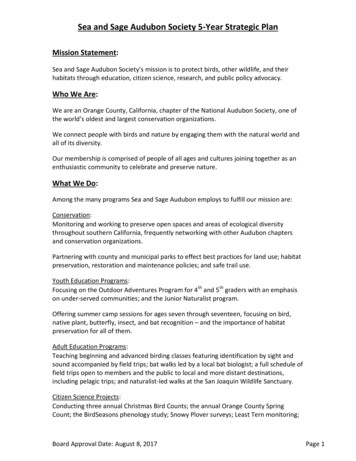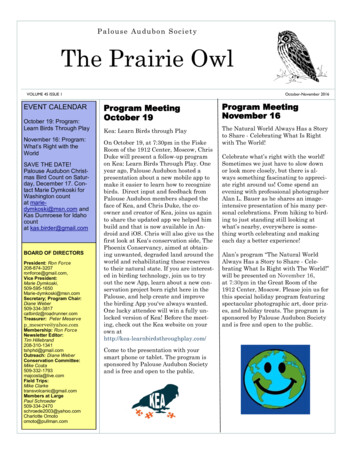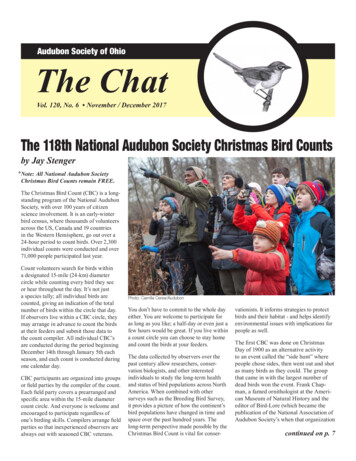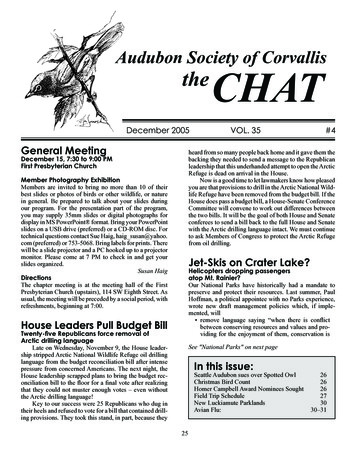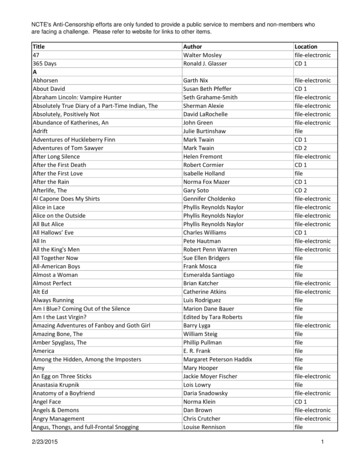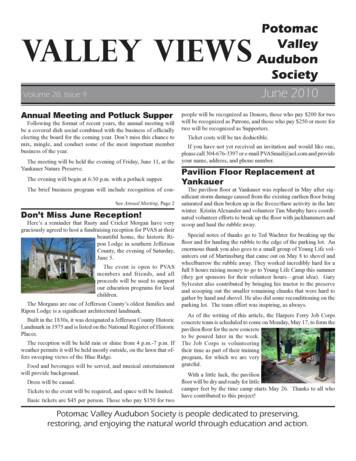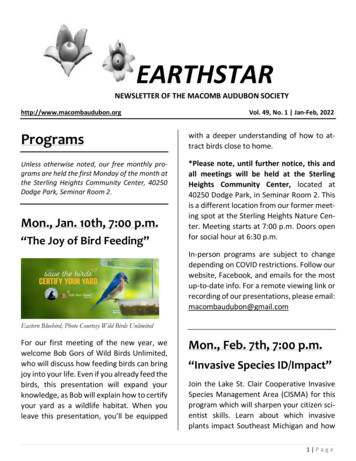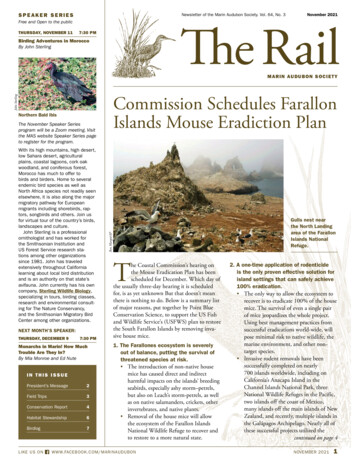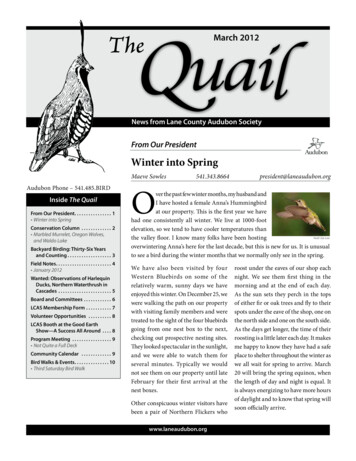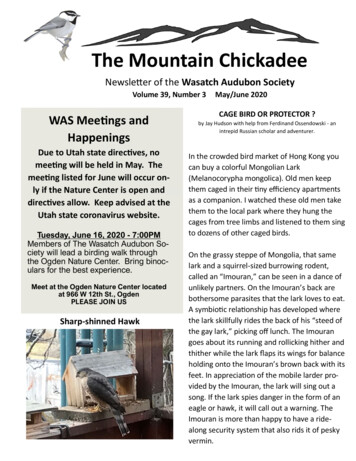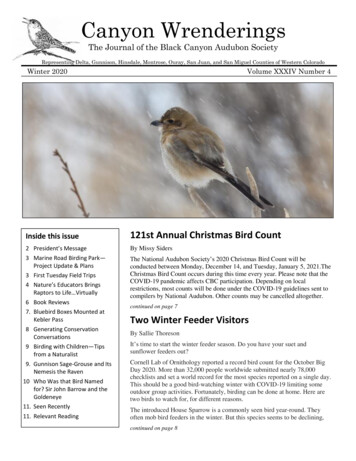
Transcription
Canyon WrenderingsThe Journal of the Black Canyon Audubon SocietyRepresenting Delta, Gunnison, Hinsdale, Montrose, Ouray, San Juan, and San Miguel Counties of Western ColoradoWinter 2020Inside this issue2 President’s Message3 Marine Road Birding Park—Project Update & Plans3 First Tuesday Field Trips4 Nature’s Educators BringsRaptors to Life Virtually6 Book Reviews7. Bluebird Boxes Mounted atKebler Pass8 Generating ConservationConversations9 Birding with Children—Tipsfrom a Naturalist9. Gunnison Sage-Grouse and ItsNemesis the Raven10 Who Was that Bird Namedfor? Sir John Barrow and theGoldeneye11. Seen Recently11. Relevant ReadingVolume XXXIV Number 4121st Annual Christmas Bird CountBy Missy SidersThe National Audubon Society’s 2020 Christmas Bird Count will beconducted between Monday, December 14, and Tuesday, January 5, 2021.TheChristmas Bird Count occurs during this time every year. Please note that theCOVID-19 pandemic affects CBC participation. Depending on localrestrictions, most counts will be done under the COVID-19 guidelines sent tocompilers by National Audubon. Other counts may be cancelled altogether.continued on page 7Two Winter Feeder VisitorsBy Sallie ThoresonIt’s time to start the winter feeder season. Do you have your suet andsunflower feeders out?Cornell Lab of Ornithology reported a record bird count for the October BigDay 2020. More than 32,000 people worldwide submitted nearly 78,000checklists and set a world record for the most species reported on a single day.This should be a good bird-watching winter with COVID-19 limiting someoutdoor group activities. Fortunately, birding can be done at home. Here aretwo birds to watch for, for different reasons.The introduced House Sparrow is a commonly seen bird year-round. Theyoften mob bird feeders in the winter. But this species seems to be declining,continued on page 8
President’s MessageI’m writing this mid-November. The holidays are approaching. I am thankfulfor all the birds that have provided endless hours of entertainment for us whilewe’ve been staying safe at home.We are sorry that, due to COVID-19, BCAS has only been able to lead a fewfield trips and have a few Zoom online presentations. It’s not the kind of yearthat we would like to see! Go out birding on your own! I guess it is a year forDo-It-Yourself birding trips, socially distanced, with people in your pod. Sendme an email about the favorite trips you’ve done this year. Send us photos forour web site or Facebook page. Or you could ask me about my favorite placesto go during any season.We hope that we are able to pull off the Christmas Bird Counts this year (seearticle on cover). Expect them to have fewer participants, be sociallydistanced, masked, and with no social gatherings before or after as is the usualprotocol.Winter is starting. We’ve had a few cold days. Have you been seeing birdsmigrating south? Thousands of Sandhill Cranes have been passing over—some headed south over the mountains to winter in New Mexico and somespending the winter in Delta on G50 Road west of town. Different ducks andgeese are arriving from the north. Wintering hawks and bald eagles arestarting to be seen.There have been some good, uncommon birds around, too, so keep your eyesopen and share your sightings—some of the best birds I have seen include theBrown Thrasher, Pacific Loon, Franklin’s Gull, and Solitary Sandpiper.Membership RenewalPlease remember to renew your membership. Local memberships expire foreveryone in December. Please enew online or by check. See the membershipform on the last page of this newsletter. When you renew, your membershipwill be paid through December 2021.Bruce AckermanWatch Your Inbox for an Email BallotBCAS board elections are usually held at the annual meeting. Because theannual meeting was canceled, elections will be by online survey. Watch youremail for an invitation to participate in the electronic survey and ballotcasting.Submit Your Ideas and Articles to Canyon WrenderingsDo you have an idea for a story? Would you like to submit an article or photosto this newsletter? Please contact the managing editor below.Canyon WrenderingsThe quarterly journal of the Black Canyon Audubon Society. Vol 34. No 4.Managing editorMary Menz at mary.t.menz @gmail.comON THE COVERNorthern Shrike on a backyard bush. Missy Siders.2BLACK CANYON AUDUBON SOCIETYOFFICERSPresident—Bruce Ackerman (Montrose)(727) 858-5857Bruceackermanaud @aol.comVice President—OPENSecretary—Sallie Thoreson (Montrose)(970) 249-1869salliet900 @aol.comTreasurer—Dian Torphy (Cedaredge)(303) 709-4386bcas.torphy @gmail.comPast President—Jon Horn (Montrose)(970) 209-5404Jon horn @alpinearchaeology.comBOARD OF DIRECTORSKristal Cooper (Montrose)(580) 919-5987nationalparkfan1 @yahoo.comMary Costello (Montrose)(208) 610-4896mc.costello5 @gmail.comCarrie Krickbaum (Ridgway)(970) 209-3703ridgway.naturalist @state.co.usDon Marsh (Ridgway)(209) 256-5744ridgwaybrdr @gmail.comMelissa (Missy) Siders (Montrose)(970) 275-6639missy.siders @gmail.comCOMMITTEE CHAIRSAudubon CO Council rep.—OPENEducationSheryl Radovich (970) 240-3788canyon.creek @bresnan.netConservation—Sallie Thoreson(970) 249-1869salliet900 @aol.comField Trips—Don Marsh (see above)Membership—Missy Siders (see above)Publicity—Susan Werner (970) 688-0757susanw@springsips.comPrograms— OPENWebsite Manager—Jon Horn (see above)AD HOC COMMITTEES (ANNUAL EVENTS)Montrose County Fair—OPENBird Banding—Carrie Krickbaum (see above)Christmas Bird Count Team—ArdenAnderson, Adam Petry, Amy Seglund,and Missy Siders (see page 3 for contactinformation)Eckert Crane Days—Dian TorphyA note about email addresses in thisnewsletter: All emails have an extra spacebefore the @ sign to discouragewebcrawlers from spam activities.
Marine Road Birding Park—Project Update & Plans Moving ForwardBy Kristal CooperMarine Road Park is a proposed birding park on a cityowned property in Montrose along the Uncompahgre River.I am happy to report that despite events of 2020 setting usback, they have not knocked us out.On the morning of September 25, members of the BCASboard of directors and other friends of this project met at thesite to have a walk-n-talk with Jackie Bubenik, the newParks & Rec supervisor for the city of Montrose.During the hour-long meeting, we asked and answered lotsof questions, getting him up to speed, and showing him thegreat potential of the property.department money would be going to the new amphitheaterin Cerise Park.Follow up emails to Kendall Cramer, the City's grantwriting guru, yielded exciting news. He confirmed that theCity is planning to partner with the University TechnicalAssistance (UTA) program in spring of 2021. The UTAprogram will provide graduate students opportunities tocreate conceptual designs of this project’s desired amenities,which will set BCAS and the City up to apply for grantssuch as the Great Outdoor Colorado funds later next year.We had another good surprise in October when we learnedthat the City has annexed a 2.82-acre parcel along the riverand immediately north of the Marine Road property. Theaddition includes the northern portion of the northern duckpond and some marshland farther downstream. Aconversation with the assistant city manager confirmed thatthe intention is to fold this into the BCAS project.It appears that all parties involved are engaged andinterested in moving this forward and making it a real pointof interest for the Montrose area! First Tuesday Field Trip to Marine RoadA map of the Marine Road parcel where the proposedbird park will be located.Board member Jon Horn was especially helpful, suggestingminnows over chemical mosquito cakes to address the bugs.Jon also pointed out that the odor seemed more like it wascoming from a malfunctioning septic tank than the ponds.In the end, Jackie indicated that he was supportive of theBCAS plans and that he'd be happy to help if BCASattempts to find funds for planning. He was clear that wecan't expect any cash outlay from the City in 2021, as itsbudget had already been written and most of the parksBruce Ackerman led a socially-distanced field trip toMarine Road November 3. Twelve participantsattended. Birds of note included a Black-Crowned NightHeron and Sharp-Shinned Hawk. Judith Lopez.First Tuesday Field TripsThese field trips will continue as COVID-19 protocols allow: with small groups, driving separately, and wearingmasks. Mark your calendars for December 1, January 5, February 2, and March 2. Meet at 9 AM at the northeasterncorner of the Gold’s Gym parking lot in Montrose (corner of Hillcrest and East Main St). All skill levels are welcome.Bring a snack, water, binoculars, and field guides. Trips generally last until NOON. Contact Don at (209) 256-5744 orat ridgwaybrdr @gmail.com for more information. 3
Nature’s Educators Brings Raptors to Life VirtuallyBy Carrie KrickbaumOn October 1, 27 BCAS members were treated to a livevirtual presentation via ZOOM during which Devin Jaffe,founder of Nature’s Educators. She shared with viewerssome of the raptor ambassadors that live at the NaturesEducators wildlife centers.Many people may think that “birds of prey” and “raptors”are the same thing. Actually, a bird of prey is any bird thateats meat—like shrikes, herons, kingfishers, and penguins.But a raptor, which comes from the Latin word rapier,means to abduct or seize, as in using talons to hunt for prey.Raptors include hawks, eagles, and falcons. Raptors havetalons for seizing prey. A note: Vultures and condors havefeet more like turkeys, but because they have cousins inSouth America and Africa that hunt like typical raptors, theyare included in the raptor classification. The raptor gueststhat were introduced during the presentation included anAmerican Kestrel, an Eastern Screech Owl, a FerruginousHawk, and animmature Bald Eagle.Doodlebug, a threeyear-old Americankestrel was introducedfirst. She is animprinted and captivebred bird. Most of theambassadors arecaptive bred because,older, injured birds thatcan’t be released aren’ttrained fordemonstration. Humanimprinting means that abird is bonded to ahuman.The American Kestrel is the smallest falcon. This oneweighs 110 grams. Some facts about the kestrel: They can turn their heads 180 degrees, see more shadesof color than other birds, and can hover to look formovement of prey. They can hold their head in the same position while therest of the body is moving about. Their preferred mealsinclude small birds, rodents, snakes, dragonflies and evenbats—all seen from a powerline or other stationary highpoint. They have a stripe below the eye. All falcons have thesemalar stripes to absorb light while hunting, similar to acheetah. Falcons are closely related to parrots!4An Eastern Screech Owl named Thistle made an appearancenext. These birds are sometimes called “little horned owls,”because they look like a small version of a Great HornedOwl, yet they only weigh 140grams. Colorado is home toboth Eastern and Western Screech Owls, depending onwhich side of the Continental Divide you’re located. Theyboth make different sounds which you can check out herehttps://www.allaboutbirds.org/guide/Eastern ScreechOwl/soundsThis bird also was raised in captivity and is an imprint.Actually, owls are the hardest raptor to raise in captivity,especially if they were born in the wild, injured, and thencan’t be released. They are avery primitive bird. Devinsays they are also verystubborn and take three timeslonger to train than otherraptors. Owls are mostlynocturnal, though a few arediurnal. Others arecrepuscular and hunt attwilight. Screech owls willgrow to full size in six weeks.Owls are zygodactyl, meaningthey have two toes in frontand two toes in back. In addition, one of those toes in back isdouble-jointed, so they can move it to the front to helpprovide more flexibility while hunting. The tufts of feathersthat resemble ears are called plumicorns. The origin is fromthe Latin words pluma, which means feather, and cornu,meaning horn. There are three main theories about thepurpose of these feathers. One is camouflage, another is forcommunication, and the third is that they may help catchsound.The Eastern Screech Owl has some other adaptations,including: A fairly flat face and a facial disk that funnels sound toits ears. The ears are at asymmetrical locations on its head tohelp triangulate sound. Extremely large eyes compared to the head. They are sobig that they touch each other inside the skull and touch theback of the skull. The large eyes allow for many rod cells tocapture light. They don’t have has many cone cells, whichdetect color. This means owls see more in grey tones. Specialized feathers to alter air turbulence and absorbsound so that they can hunt without making much noise.
feathered legs. The naked legs make it easier for them tocatch fish!A Ferruginous Hawk by the name of Storm was presentednext. The bird is about five pounds and is one year old. Thisis one of the raptors that Devin uses for hunting, along with aPrairie Falcon, two Harris Hawks that hunt as a team, andoccasionally a Great Horned Owl.The Ferruginous Hawk is the largest hawk species and it getsits name from the rust to reddish-brown colored feathers.They look similar to a Red-tailed Hawk, but can bedistinguished by their feathered legs. A Red-tailed Hawkdoes not have feathered legs. (Rough-legged Hawks andGolden Eagles also have feathered tarsi, or feet.) TheFerruginous Hawk also has a huge mouth that extends backpast the eyes. This makes it look like the bird is smiling!These hawks mostly hunt prairie dogs so will be seen on theground. They have lightning fast feet to grab prairie dogs.They will also hunt jack rabbits. This is aided by the force oftheir talons, which can grab with 270 pounds of pressure persquare inch! Also, Ferruginous Hawks have a light morphand a dark morph like many hawks. The light morph has themore rust colored shoulder feathers and lighter feathersunderneath. The dark morph is more of a solid darkchocolate color. The typical tail is solid white with grey or astriped brown or red tail. Like many raptors, they havecounter-shading, or lighter coloring underneath so preycannot see them as well from below, and darker colors ontop so they blend in while feeding on the ground. Here is alink to a video of Devin with a Ferruginous Hawk eo?fr mcafee&p nature%27s educators#id 3&vid 08b3bf97bcfe35f1c39bedfa1b6ba268&action clickThe final guest was an immature Bald Eagle called Juno. Heweighs 10 pounds and is still speckled at two-years-old.Generally, the first 3-4 years a Bald Eagle is not whiteheaded. One easy way to tell the difference between aGolden Eagle and an immature Bald Eagle is by looking atthe beak (if you are close enough to see it). Bald Eagle beaksare very large compared to the head, especially in length.Also, they have naked legs, whereas the Golden Eagle hasJuno came to Nature’s Educators from Nebraska. He wasbeing illegally fed near a popular lake and becamehabituated to people. They determined this because he wasfound in three different vehicles stealing fish out of coolers.So, Nebraska Game and Fish took him to a rehab facility inNebraska and put him with two adult Bald Eagles, hoping hewould learn to act “normal” around humans. Devin calledhim a food imprint because he associated humans with foodand did not fear humans like wild Bald Eagles do. BaldEagles eat mostly fish but will also feed on carrion,waterfowl, and small mammals. They are alsokleptoparasitic and will often steal from other birds. They dothis to Osprey, because Osprey are much better at catchingfish.Attendees of this presentation also learned that raptors willmake a cast of the animal material they can’t digest andcough it up like an owl pellet. Owl pellets include bonebecause they cannot break down bone. An eagle, however,can break down bone. Eagles have very strong stomach acidsto do this but they will cast other indigestible parts such asfeathers, fur, and some bone. Eagles, like most other birds,also have a crop where they can store food for several hours(or days) before digesting it. This is beneficial when food isscarce.The program finished up with a question and answer period.Devin talked about her falconry and the variety of residentsat Nature’s Educators facilities, which includes other birdslike pigeons, parrots, a chukar, and lizards and snakes! Devin with Skeedo presenting virtually to students fromColorado, Washington, Arizona, Tennessee, SouthCarolina, Texas, Maine, Massachusetts, Hawaii, Idaho, andMexico in partnership with Environment for the Americas.All photos Nature’s Educators.5
Book ReviewsOwls of the Eastern Ice: A Quest toFind and Save the World’s Largest OwlWhat It’s Like to be a BirdReviewed by Sandy BeranichMany of us have the Sibley Bird Guides by David AllenSibley, and appreciate the details of drawings and text aboutbird identification. This nontechnical book by Sibley startsout with 24 pages of really fun facts about birds such as“small birds have over 2000 feathers” or “If you ‘ate like abird’ you’d eat more than 25 large pizzas a day.” There areplenty of these facts you might want to bring up during aZoom meeting or a social distancing family gathering.In 2000, the author Jonathan C. Slaght and a friend werehiking in coastal southeast Russia, north of Vladivostok,when they unexpectedly flushed an enormous and panickedbird in the canopy abovethem. Later identified as theBlakiston’s Fish Owl--thelargest owl in the world—this was Slaght’s impression:“Backlit by the hazy gray ofa winter sky, it seemedalmost too big and toocomical to be a real bird, asif someone had hastily gluedfistfuls of feathers to ayearling bear, then proppedthe dazed bear in the tree.”This book is more than anarrative of an Americanscientist studying an unusualowl in an extremeenvironment to complete his PhD requirement. This book ismuch about the uniqueness of the fish owls and the manydetails and perils related to conducting a field study in thisremote area of Eastern Russia. It is also the author’s way tointertwine descriptions of his environment, local village lifeand customs, wildlife populations (this is also home to theendangered Amur Siberian Tiger), and the threats loggingbrings to the owl habitat.Slaght introduces his many field assistants who eachcontribute their own unique personality shaped by theremoteness of the area and daily efforts to survive. Spendingnights in a tent with subzero temperatures during the winterwaiting on a fish owl to call leaves plenty of time to hear lifestories. His Russian hosts are no less unique. One hermitasked the author in all seriousness if “the gnomes came totickle his feet last night.” All people he met were welcomingand supportive of his work.The remote human populations in this part of Russia haveadapted to simple living conditions and depend on skills ofhunting, fishing, and trading for supplies. All visitors arewelcomed—even scientists there to study owls. Livingremotely with little transportation available on a regularbasis, personal ingenuity becomes a survival necessity (ducttape is another one). Slaght shares it all in this book.He writes with a sense of humor and acceptance of theunusual and unforgiving world he temporarily inhabited.This book is available through the ColoradoLibrary System. 6Reviewed by Sallie ThoresonThe heart of the book is the Portfolio of Birds. Sibleypresents 87 groups of birds with drawings and short essaysabout the amazing things birds do—or what it’s like to be abird. The essays are broad and overlapping, so this book isbest read not cover-to-cover, but savored in randomreadings.After a lifetime of studying and drawing birds, Sibleyconcludes that birds are motivated by more than strictlybiological (in the DNA sense) instincts. He dares to say birdshave feelings like attraction, satisfaction, pride, anxiety, etc.,and that birds have to make many decisions when nestbuilding, choosing a mate, when to migrate, what seed tochoose at a feeder, or which plant to visit. Of course, this ishighly anthropomorphic, but it rings true to any of us whoobserve birds.Birds have individualpersonalities and certainlydemonstrate adaptive behaviors.Two personal examples: Wehave a “woodpecker junco” thatprefers suet to eating seeds on theground with fellow juncos. Eachyear we seem to have one junco(the same one?) that tries tofigure out ways to eat from thesuet feeder and hangs aroundwhen woodpeckers andnuthatches hammer away at thesuet, sprinkling available suet particles on the tree or ground.Also, when robins are feeding their young, an adult maleseems to size up a worm to see if it’s the right size to bringto the nest or decide that it should be consumed on the spot.The lack of an index is maddening, however. There is noway to search for individual species or find which essayscover specific bird life topics. For example, you can’t crossreference the essays that touch on feathers or feedingbehaviors. On the other hand, if you want to sit back andmeander through a book, knowing you will enjoy everypage; well, this is your book. Consider giving the book as aholiday gift and put it on your personal wish list.
Christmas Bird Count continued from coverDue to the COVID-19 pandemic, this year’s Christmas BirdCount requires a few changes to keep everyone safe. PerNational Audubon guidelines, BCAS will run a safe andsocially distanced CBC, if local rules allow.Bluebird Boxes Mounted atKebler Pass All in-person compilation gatherings are cancelled. Social distancing and/or masking are required at all timesOn October 9, BCAS members joined US Forest Servicewildlife biologist Valerie Horncastle on Kebler Pass toposition and hang 20 bluebird boxes on the Grand MesaUncompahgre and Gunnison National Forest.in the field. Carpooling may only occur within existing familiar orsocial “pod” groups. Activities must comply with all current state and municipalCOVID-19 guidelines.The bluebird boxes were constructed by member Jon Horn.They were installed in a northeast direction and filled withwood shavings. They will be checked next year foroccupants.Given the rapidly changing conditions of COVID-19, countleaders are not ready to set dates or finalize how counts willbe conducted at this time. The Montrose Count is December19 and the Gunnison Count is December 10. Contact tripsleaders below to learn more. Other Information will beshared via Bruce Ackerman in his BCAS President updatesvia email. If you have helped in the past, group leaders maybe contacting you to see if you are available and willing tohelp.Thanks to members Robin Nicholoff, Ames Rau, TimShortell, and Linda Hansen for organizing this activity. Gambel’s Quail Missy Siders.If you are unable to participate in the count circles this year,you can still participate by doing a count at your feeders.These counts need to be conducted on the same day as thecount circles and must be located within the count circle.Contact your count leader for more information on feedercounts. If you see interesting birds during the same week asyour local count, you can report those to the count to add tothe count week list of species.Questions? Please contact the count leaders!Four of five volunteers, left to right: RobinNicholoff, Ames Rau, Valerie Hardcastle, and TimShortell. Linda Hansen.Delta: Amy Seglund at amy.seglund @state.co.usGunnison: Arden Anderson at arden @gunnison.comHotchkiss: Adam Petry at petry @westernbiology.comMontrose: Missy Siders at missy.siders @gmail.com 7
Generating Conservation ConversationsBy Sallie Thoreson, Conservation ChairBLM Colorado’s Oil and Gas Lease SalesUSFS Proposal to Revise its Oil and Gas RegulationsThe BLM continues to submit oil and gas leasing sales forparcels of land in Colorado, generally in the northwesterncounties and northern Front Range counties of Larimer andWeld. The National Audubon Society (NAS) closely followsthis issue and provides detailed comment for each scoping,review, and final leasing events.To streamline leasing and development, the US ForestService is prioritizing energy development over water,wildlife, and recreation interests. The NAS reports “we needscience-based management of our public lands, not thisunbalanced approach. We hope to squash these misguidedaspirations and make that argument in [our] comments.” TheBCAS signed onto the 33-page comment letter that NASsubmitted in November.NAS has been adamant that future leasing should be haltedin sage-grouse habitat until BLM has developed a legallycompliant, enforceable approach to prioritizing leasing anddevelopment outside sage-grouse habitat, as directed by the2015 Sage-grouse Plans.Many of the proposed lease sale parcels in the NorthwestDistrict contain migration corridors, high-priority big-gamewinter habitats, and production areas for elk and pronghorn.The NAS supports the Colorado Parks and Wildlife (CPW)recommendations that BLM implement specific stipulationsto protect these areas and limit the density of surfacefacilities.The NAS also asks that BLM consider wildernesscharacteristics, cumulative impacts, impacts to groundwater,potential climate impacts, and the need for regulations ofpetroleum product waste and flaring.The BCAS has regularly signed on with other state Audubonchapters to the comment letters submitted by AudubonRockies and the NAS. The latest from Audubon Rockies isthat that BLM has, to date, failed to act on most of therecommendations, but has deferred leasing on one 240-acreparcel in sage grouse habitat.Colorado Oil and Gas Commission (COGCC)Legislation passed last year changed the mission of theCOGCC to mandate that the Commission must now protectthe public and wildlife when issuing permits for oil and gasoperations. The COGCC has begun the rulemaking processto make decisions on how to implement this new mission.The wildlife section (1200 Series) of the rules deal with habitatand species protection. The main issues, according to NAS, areto ask COGCC to: increase protection for certain wildlifespecies—including increased buffers around Greater andGunnison Sage-Grouse leks, and suitable nesting areas forWestern Yellow-Billed Cuckoo and Southwest WillowFlycatcher; enhance riparian-area protections; prohibit padconstruction in big-game migration corridors; ensurecompensatory mitigation benefits wildlife; and protectbiological resources.8Conservation Priorities under a New AdministrationConservation organizations are putting together conservationand environmental priorities and plans for life during theBiden-Harris administration. Policies and rules instituted bythe Trump administration continue to be challenged in thecourts. Additional tools available to the new administrationare executive actions, working with Congress through theCongressional Review Act to rollback some rules andregulations, and additional legislation that address climatechange and habitat and species protections. Two Winter Feeder Visitors continued from covereven in its native habitat in Europe. The same is true in theUS. Cornell’s Project FeederWatch data confirms a 22%decline in flock sizes at feeders from 1996 to 2016. Thedecline is in urban and suburban areas, not in rural areas.Why? The decline doesn’t seem to be related to hawknumbers, but is possibly due to pollution, feral cats, loss ofgreenspace, and loss of food sources. This highlights theneed for bird-friendly yards with plants and trees thatencourage insects birds need for breeding and nest raising.On the other hand, Project FeederWatch has reported anincrease for the bushtit in the SW region of the US (CA, NV,AZ, NM, UT and CO). This small brown-gray bird hasincreased regionally from observations at 11% of winterfeeders in 1990 to 35% in 2019. Sightings in Colorado arereported at 26% to 31% of the state FeederWatch sites, withan average group size of six. Again, Cornell has notconfirmed any reasons for this increase. Bushtit groups mayvisit suet feeders (like other insect eaters such aswoodpeckers and chickadees) and could also be attracted tohulled sunflower seeds, peanuts, and mealworms. We seebushtits year-round in the BCAS area.Contribute to science and the local economy and enjoybirdwatching. More details and good bird identificationresources are available at https://feederwatch.org/. Maybe,you’ll draw in some bushtits this year!
Birding with Children—Tips from a NaturalistThe Gunnison Sage-Grouse and ItsNemesis the RavenBy Carrie KrickbaumBy Sallie Thoreson“Chick-a-dee-dee-dee, chickadee in the tree. I see achickadee, chickadee in the tree.”The sagebrush-steppe ecosystem is a rich web of plants andanimals. It is more than just sagebrush and sage-grouse. Thesagebrush steppe is home to more than 290 species of birds,87 species of mammals, and a complex of sagebrush,grasses, forbs, and shrubs. Each member of the communityhas coevolved into a balance, but, when the balance isdisrupted, one or more species may decrease in numbers todangerous levels. One example of this is the relationshipbetween Gunnison sage-grouse and ravens.Making up quick songs while hiking with children is a funway to connect with them and also to reinforce names andsongs of birds. Chickadees are a favorite bird for kids andadults because the words we use to describe their song isalso their name.Another fun one I’ve done with kids on the trail is the Rubycrowned Kinglet. We call it the “cheeseburger bird” becausethe mnemonic for its song is “cheeseburger, cheeseburger,cheeseburger.” Mnemonics—words to help us remember—are fun and easy to learn. Check out this ne-12-tricksremembering-bird-calls.How to Share Your Love of Birds with KidsSharing your love of birding can be as simple as buying apair of binoculars and an age-appropriate bird book, ortaking walks together to just look and listen.There are also many children’s books that intr
The introduced House Sparrow is a commonly seen bird year-round. They often mob bird feeders in the winter. But this species seems to be declining, continued on page 8 Inside this issue President’s Message 3 Marine Road Birding Park— Project Update & Plans 3 First Tuesday Field Tr

